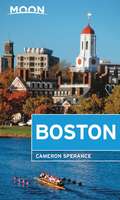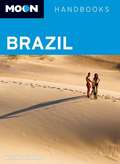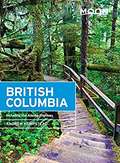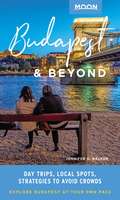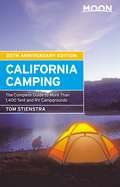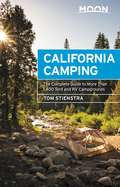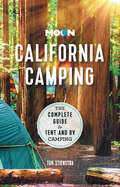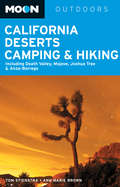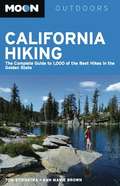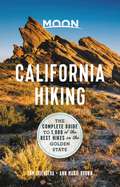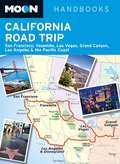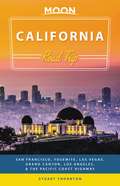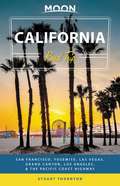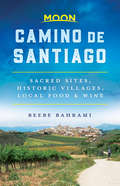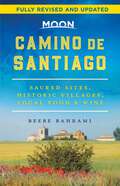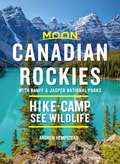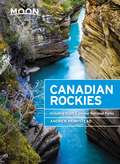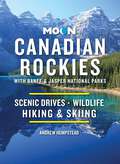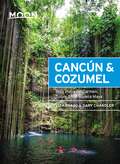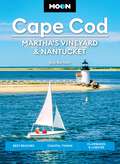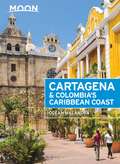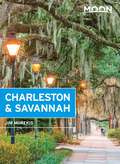- Table View
- List View
Moon Boston (Travel Guide)
by Cameron SperanceCatch a game at Fenway, watch the rowboats on the Charles, or snag a seat at the bar at the Neptune Oyster: Experience the best of Beantown with Moon Boston.Navigate the Neighborhoods: Follow one of our guided neighborhood walks through Beacon Hill, the North End, Downtown Boston, Back Bay, and moreExplore the City: Retrace the founders' footsteps on the Freedom Trail or peruse French impressionist paintings at the Boston MFA. Shop the boutiques on Newbury Street and stroll the picturesque Harvard campus in Cambridge. Sail out to the Boston Harbor Islands and go whale watching, or grab a Fenway Frank and root for the Red Sox at America's oldest ballparkGet a Taste of the City: Sample oysters by the dozen or decide who has the best red sauce and cannoli in the North End. Chow down on classics like lobster rolls and "chowdah," indulge in a Boston cream pie, or snack your way through a historic open-air market Bars and Nightlife: Relax at a waterfront whiskey bar, chat with the bartender at a local Irish pub, or catch the game at a neighborhood sports bar. Take a sunset photo of the Boston skyline from a rooftop bar, sip on innovative cocktails, or see what's on tap at a craft breweryLocal Advice: Cameron Sperance shares his expertise and love of his adopted cityFlexible, Strategic Itineraries, including the three-day best of Boston, a weekend with kids, and more, plus day trips to the Boston Harbor Islands, Lexington and Concord, Salem, Provincetown, and the Outer CapeTips for Travelers including where to stay and how to navigate "the T," plus advice for international visitors, LGBTQ travelers, seniors, travelers with disabilities, and families with childrenMaps and Tools like background information on the history and culture of Boston, full-color photos, color-coded neighborhood maps, and an easy-to-read foldout map to use on the goWith Moon Boston's practical tips and local insight, you can experience the city your way. Expanding your trip? Grab a copy of Moon New England. Hitting the road? Check out Moon New England Road Trip.
Moon Boston: Neighborhood Walks, Historic Highlights, Beloved Local Spots (Travel Guide)
by Cameron SperanceStroll through history, catch a game at Fenway, or snag a seat at a famous oyster bar: the best of Beantown is yours with Moon Boston.Navigate the Neighborhoods: Follow one of our self-guided neighborhood walks through Back Bay and Cambridge or along the Boston HarborExplore the City: Retrace the founders' footsteps on the Freedom Trail or peruse the works of Renoir and Van Gogh at the Boston Museum of Fine Arts. Shop the unique boutiques or designer stores on Newbury Street and wander Harvard's picturesque campus in Cambridge. Sail out to the Boston Harbor Islands for camping and clambakes or grab a Fenway Frank and root for the Red Sox at America's oldest ballparkGet a Taste of the City: Sample oysters by the dozen or decide who has the best red sauce and cannoli in the North End. Chow down on classics like lobster rolls and "chowdah," indulge in a Boston Cream Pie, or snack your way through a historic open-air market Bars and Nightlife: Relax at a waterfront whiskey bar, chat with the bartender at a local Irish pub, or catch the game at a neighborhood sports bar. Take a sunset photo of the Boston skyline from a rooftop bar, sip on innovative cocktails, or see what's on tap at a craft breweryLocal Advice: Cameron Sperance shares his expertise and love of his adopted cityFlexible, Strategic Itineraries, including the three-day best of Boston, a weekend with kids, day trips to Lexington and Concord, Salem, Provincetown, and moreTips for Travelers including where to stay and how to navigate the T, plus advice for international visitors, LGBTQ+ travelers, seniors, travelers with disabilities, and families with childrenMaps and Tools like background information on the history and culture of Boston, full-color photos, color-coded neighborhood maps, and an easy-to-read foldout map to use on the goWith Moon Boston's practical tips and local insight, you can experience the best of the city. Expanding your trip? Grab a copy of Moon New England. Hitting the road? Check out Moon New England Road Trip.
Moon Brazil
by Michael SommersJournalist Michael Sommers guides travelers to the best that Brazil has to offer, from surfing, hang gliding, and enjoying the sizzling nightlife in Rio to venturing into the Amazon to witness the Meeting of the Waters, where the Rio Negro and Rio Solimões join to form the world’s mightiest river: the Amazon. Sommers also includes unique trip strategies like A Tale of Two Amazon Cities-which provides details on exploring the rainforest between Manaus and Belém-and Gastronomic Brazil, a mouthwatering tour of Brazil’s cuisine. With expert advice on viewing popular attractions like Iguaçu Falls and Corcovado, as well as escaping the crowds in less frequented places, like Bahia's rustic fishing villages,Moon Brazilgives travelers the tools they need to create a more personal and memorable experience.
Moon British Columbia: Including the Alaska Highway (Travel Guide)
by Andrew HempsteadBritish Columbia is filled with vibrant cities, secluded beaches, and old-growth rainforests. Experience the best of this wild and beautiful province with Moon British Columbia. Inside you'll find:Flexible itineraries, from one week in Vancouver and Victoria to a two-week tour of the entire provinceStrategic advice for outdoor adventurers, foodies and wine lovers, families, and moreMust-see highlights and unique experiences: Try to spot wild bears, moose, and elk, go whale-watching on the Pacific, or snorkel with seals. Learn about the First Nations tribes' colorful totem poles and sample indigenous foods, or sip your way through the wines of the lush Okanagan Valley. Kayak through icy fjords, ski Whistler's world-class slopes, or drive the famed Alaska HighwayReliable tips from BC local Andrew Hempstead on where to eat, where to stay, and how to get aroundFull-color photos and detailed maps throughoutBackground information on the landscape, culture, history, and environmentIn-depth coverage of Vancouver, Victoria and Vancouver Island, the Sunshine Coast, Sea to Sky Highway, Whistler, Gold Nugget Route, the Okanagan Valley, the Kootenays, the Canadian Rockies, Glacier National Park, Revelstoke, Kamloops, Mount Robson, Cariboo Country, Prince George, Prince Rupert, Haida Gwaii, Stewart-Cassar Highway, Alaska Highway, and the YukonWith Moon British Columbia's practical tips and local know-how, you can plan your trip your way.Hitting the road? Try Moon Vancouver & Canadian Rockies Road Trip. Craving more of Canada's incredible wilderness? Check out Moon Banff National Park or Moon Canadian Rockies.
Moon Budapest & Beyond: Day Trips, Local Spots, Strategies to Avoid Crowds (Travel Guide)
by Jennifer D. WalkerFrom soaking up Budapest's poignant history and vibrant nightlife to soaking in thermal baths, savor one of Europe's most stunning cities with Moon Budapest & Beyond.Explore In and Around the City: Get to know Budapest's most interesting neighborhoods, like Castle Hill, South Buda, South Pest, and the historic Jewish quarter, and nearby areas, including Gödöllö, Lake Balaton, the Eger wine country, Pécs, and moreGo at Your Own Pace: Choose from multiple itinerary options designed for foodies, history buffs, art lovers, outdoor adventurers, and moreSee the Sights: Soak in the thermal Széchenyi baths, meander through Magyar history at the Hungarian National Museum, or take in views of the city from 170 meters above the Danube. See Europe's largest synagogue and catch a performance at the palatial Opera House. Hike to the top of the Elizabeth Lookout, or go cave-diving in the Buda HillsGet Outside the City: Explore the vineyards of the Valley of Beautiful Women, stroll through historic Hungarian folk villages, or go canyoning in the Pilis HillsSavor the Flavors: Grab a mouthwatering lángos from a food truck, tuck into a rich authentic goulash, linger over coffee at a riverside café, or indulge in contemporary farm-to-table cuisineExperience the Nightlife: Hop between eclectic ruin bars in the bustling Jewish Quarter or attend a Saturday "Sparty" in one of the city's famous spas. Sample Hungarian wines at a tasting room, sip creative concoctions at a cocktail bar, and watch the sunset over the Danube with a local craft beer in hand Get to Know the Real Budapest: Follow honest suggestions from Budapest local Jennifer D. WalkerFull-color photos and detailed maps, including a full-color foldout mapHandy Tools: Background information on Budapest's history and culture, plus tips on sustainable travel, what to pack, where to stay, and how to get aroundDay trip itineraries, favorite local spots, and strategies to skip the crowds: Take your time with Moon Budapest & Beyond.Exploring more of Eastern Europe? Check out Moon Prague & Beyond.
Moon California Camping
by Tom StienstraTom Stienstra, the nation's top-selling outdoors writer, invites you to spend the night under the stars with the latest edition of Moon California Camping. Extremely comprehensive and packed with useful information, Moon California Camping covers more than 1,400 camping options throughout the state, from sites nestled among towering redwoods to remote backcountry destinations in the High Sierra to sun-drenched, beach-side campgrounds. Detailed descriptions, directions, contact information, and Stienstra's signature scenic rating are provided for each site. Stienstra also includes lists of the best campgrounds, such as Best for Hikes with Views and Best Family Destinations, as well as sixty pages of helpful camping tips. With Moon California Camping, seasoned outdoors enthusiasts and camping novices alike can experience the best of the great outdoors in the Golden State.
Moon California Camping: The Complete Guide to More Than 1,400 Tent and RV Campgrounds (Moon Outdoors)
by Tom Stienstra20 million acres of forest, 1,200 miles of coastline, and countless wilderness areas: find your perfect campsite with Moon California Camping.A Campsite for Everyone: A variety of campgrounds and RV parks, from secluded Sierra hike-ins to convenient roadside stopovers, including dog-friendly, family-friendly, and wheelchair accessible optionsRatings and Essentials: All campsites are rated on a scenic scale and marked with amenities like restrooms, trailhead access, picnic areas, laundry, piped water, showers, and playgroundsRecreation Highlights: Discover nearby hiking, swimming, fishing, water-skiing, whitewater rafting, hot springs, and options for winter sportsMaps and Directions: Easy-to-use maps and detailed driving directions for each campgroundSkip the Crowds: Moon California Camping contains many secluded spots and campgrounds that aren't available in the state's online reservation systemThe Top RV and Tent Sites for You: Pick the right campsite for your travel style with lists like "Best for Families," "Scenic Campgrounds," and "Best Island Retreats"Trailhead Access Campgrounds: Find sites that offer access to the John Muir Trail, the Pacific Crest Trail, and more, plus essential information on hikingTrusted Advice: Expert outdoorsman Tom Stienstra knows his stuff; he's hiked 25,000 miles in and around these campgrounds for over 30 yearsTips and Tools: Information on equipment, food and cooking, first aid, and insect protection, plus background on the climate, landscape, and history of the campgroundsWhether you're a veteran or a first-time camper, Moon's comprehensive coverage and trusted advice will have you gearing up for your next adventure.Narrowing your search? Try Moon Northern California Camping. Hitting the road? Check out Moon California Road Trip.Full coverage of: The Redwood Empire, Shasta and Trinity, Lassen and Modoc, Mendocino and Wine Country, Sacramento and Gold Country, Tahoe and the Northern Sierra, the San Francisco Bay Area, Monterey and Big Sur, the San Joaquin Valley, Yosemite and Mammoth Lakes, Sequoia and Kings Canyon, Santa Barbara, Los Angeles and San Diego (and their surrounding areas), and the California deserts, including Death Valley and Palm Desert
Moon California Camping: The Complete Guide to Tent and RV Camping (Travel Guide)
by Tom Stienstra20 million acres of forest, 1,200 miles of coastline, and countless wilderness areas: Your California camping adventure awaits! Find the perfect place to pitch your tent with Moon California Camping.A Campsite for Everyone: A variety of campgrounds and RV parks, from secluded Sierra hike-ins to convenient roadside stopovers, including dog-friendly, family-friendly, and wheelchair accessible options Ratings and Essentials: All campsites are rated on a scenic scale and marked with amenities like restrooms, trailhead access, picnic areas, laundry, piped water, showers, and playgrounds Recreation Highlights: Discover nearby hiking, swimming, fishing, water-skiing, whitewater rafting, hot springs, and options for winter sports Maps and Directions: Easy-to-use maps and detailed driving directions for each campground Skip the Crowds: Moon California Camping contains many secluded spots and campgrounds that aren't available in the state's online reservation system The Top RV and Tent Sites for You: Pick the right campsite for your travel style with lists like "Best for Families," "Scenic Campgrounds," and "Best Island Retreats" Trailhead Access Campgrounds: Find sites that offer access to the John Muir Trail, the Pacific Crest Trail, and more, plus essential information on hiking Trusted Advice: Expert outdoorsman Tom Stienstra knows his stuff; he's hiked 25,000 miles in and around these campgrounds for over 30 years Helpful resources on Covid-19 and camping in California Tips and Tools: Information on equipment, food and cooking, first aid, and insect protection, plus background on the climate, landscape, and history of the campgrounds Whether you're a veteran or a first-time camper, Moon's comprehensive coverage and trusted advice will have you gearing up for your next adventure. Narrowing your search? Try Moon Northern California Camping. Hitting the road? Check out Moon California Road Trip. About Moon Travel Guides: Moon was founded in 1973 to empower independent, active, and conscious travel. We prioritize local businesses, outdoor recreation, and traveling strategically and sustainably. Moon Travel Guides are written by local, expert authors with great stories to tell—and they can't wait to share their favorite places with you. For more inspiration, follow @moonguides on social media.
Moon California Deserts Camping & Hiking: Including Death Valley, Mojave, Joshua Tree and Anza-Borrego
by Ann Marie Brown Tom StienstraBest-selling travel authors Tom Stienstra and Ann Marie Brown offer readers their informed advice on exploring California's deserts, from climbing Death Valley's towering Telescope Peak to surveying Joshua Tree's sweeping landscape and namesake vegetation. Comprehensive and easy to use,Moon California Deserts Camping and Hikingalso provides "best-of" campground and trail lists-including Best for Kids, Best for Wildflowers, and Best for Waterskiiing-leading novice and expert outdoors adventurers alike to a wide range of camping and hiking options throughout California's dry places. Complete with clear directions to each location, detailed destination descriptions, difficulty and quality ratings for each hike, and helpful maps,Moon California Deserts Camping and Hikingprovides campers and hikers with all the necessary tools to head outdoors.
Moon California Fishing: The Complete Guide to Fishing on Lakes, Streams, Rivers, and the Coast (Moon Outdoors)
by Tom StienstraAcclaimed outdoors author and expert angler Tom Stienstra knows the best fishing spots in the Golden State, from the crystal-clear lakes dotting the Sierra Nevada to the abundant waters just off the coast of San Francisco. Moon California Fishing leads both beginner and expert anglers to the best lakes, rivers, and coasts that the state has to offer. The eighth edition of this classic guidebook offers detaileddescriptions of over 2,000 fishing locations and includes over 70 pages of fishing tips and advice. Complete with detailed regional maps as well as directions and ratings for each location, Moon California Fishing provides anglers with first-rate expert advice and all the necessary tools to headoutdoors.
Moon California Hiking: The Complete Guide to 1,000 of the Best Hikes in the Golden State
by Ann Marie Brown Tom StienstraSeasoned outdoors authors Tom Stienstra and Ann Marie Brown know the best hiking trails in the Golden State, from breathtaking coastal walks north of Los Angeles to challenging backcountry treks in the Sierra Nevadas. Including 21 new hikes and unique "best-of" lists-including Best Hikes to Waterfalls and Best Hikes to See Wildlife-Moon California Hiking leads beginner and expert hikers alike to the best trails the state has to offer. Complete with detailed regional maps, hiking tips, difficulty and quality ratings for each hike, Moon California Hiking provides hikers with all the necessary tools to head outdoors.
Moon California Hiking: The Complete Guide to 1,000 of the Best Hikes in the Golden State (Moon Outdoors)
by Ann Marie Brown Tom StienstraPack a lunch, lace up your boots, and head out to discover the best hiking trails in the Golden State with Moon California Hiking.A Hike for Everyone: Pick the right hike for you, from breathtaking coastal walks to challenging backcountry treks, with options ranging from easy day hikes to multi-day backpacking tripsBest Hikes Lists: Choose from strategic lists of the best hikes for kids, bird-watching, redwoods, vivid fall colors, waterfalls, wheelchair-accessibility, and moreEssential Planning Details: Each hike is marked with round-trip distance and estimated hiking time, as well as rated for scenic beauty and trail difficultyMaps and Directions: Find easy-to-use maps, driving directions to each trailhead, and details on where to parkSkip the Crowds: Have the trail to yourself with recommended off-the-radar hikes Expert Advice: Seasoned hikers Tom Stienstra and Ann Marie Brown offer their trusted insight and honest opinions on each trailTips and Tools: Advice on gear, first aid, camping permits, and ethical hiking, plus background information on climate, landscape, and wildlifeWhether you're a veteran or a first-time hiker, Moon's comprehensive coverage and honest expertise will have you gearing up for your next adventure.Exploring more of the Golden State? Try Moon California Camping. Hitting the road? Check out Moon California Road Trip.
Moon California Road Trip
by Travel AvalonThe top destinations in the West are within a day’s drive of one another. See them all withMoon California Road Tripas your guide. Detailed driving instructions tell you how far you’ll have to drive, how long it will take, and which highways you’ll need to follow-including information on alternate routes and the best places to stop along the way. Day-by-day itinerary suggestions tell you the best ways to spend your time: The 14-Day Best of the West Three Days in San Francisco Three Days in Los Angeles Three Days in Las Vegas One Day in Yosemite One Day in the Grand Canyon Day Trips to Wine Country And 36 easy-to-use maps keep you oriented along the way.
Moon California Road Trip: San Francisco, Yosemite, Las Vegas, Grand Canyon, Los Angeles & the Pacific Coast (Travel Guide)
by Stuart ThorntonHit the Road with Moon Travel Guides!From the waterfalls of Yosemite and the colorful Grand Canyon to the Hollywood Walk of Fame and the Golden Gate Bridge, cruise through the best of the West with Moon California Road Trip. Inside you'll find:Maps and Driving Tools: Over 40 easy-to-use maps keep you oriented on and off the highway, along with site-to-site mileage, driving times, and detailed directions for the entire routeEat, Sleep, Stop and Explore: With lists of the best hikes, views, restaurants, and more, you can ride a cable car in San Francisco or hike Half Dome, descend deep into the Grand Canyon, or hit the waves in a classic SoCal surf town. Wander through history at Alcatraz, snap a photo at Big Sur, or marvel at jellyfish at the Monterey Bay Aquarium. Chow down on an authentic Mission burrito, lunch on fish tacos by the beach, or watch the sunset from a rooftop bar in Los AngelesFlexible Itineraries: Drive the entire two-week "Best of the West," mix and match destinations for shorter road trips, or follow strategic itineraries for spending time in San Francisco, Yosemite, Las Vegas, the Grand Canyon, Los Angeles, and smaller towns along the Pacific Coast HighwayLocal Insight: Surfer and adventurer Stuart Thornton shares his thirst for the next secluded beach, quirky pit stop, and mountaintop vista Planning Your Trip: Know when and where to get gas, how to avoid traffic, tips for driving in different road and weather conditions, and suggestions for international visitors, LGBTQ+ travelers, seniors, and road trippers with kidsWith Moon California Road Trip's practical tips, detailed itineraries, and local expertise, you're ready to fill up the tank and hit the road.Doing more than driving through? Check out Moon California, Moon Grand Canyon, or Moon Yosemite, Sequoia & Kings Canyon.
Moon California Road Trip: San Francisco, Yosemite, Las Vegas, Grand Canyon, Los Angeles & the Pacific Coast (Travel Guide)
by Stuart ThorntonColorful cable cars, sunny beaches, seaside havens, and thundering waterfalls: Buckle up for the best of the Golden State with Moon California Road Trip. Inside you'll find:Flexible Itineraries: Drive the entire "Best of the West" loop, mix and match destinations for shorter road trips, or follow strategic itineraries for spending time in San Francisco, Yosemite, Las Vegas, the Grand Canyon, Los Angeles, and smaller towns along the Pacific Coast HighwayEat, Sleep, Stop and Explore: Experience California and the Southwest your way with lists of the best hikes, views, restaurants, and more. Conquer Half Dome, stroll across the Golden Gate Bridge, venture into the depths of the Grand Canyon, or snap a picture on the Hollywood Walk of Fame. Step back in time at Alcatraz, tour the opulent rooms of Hearst Castle, or marvel at the jellyfish at the Monterey Bay Aquarium. Satisfy your cravings with an authentic Mission burrito, be dazzled by an over-the-top Las Vegas show, or enjoy a technicolor sunset from a rooftop bar in Los AngelesMaps and Driving Tools: Over 40 easy-to-use maps keep you oriented on and off the highway, along with site-to-site mileage, driving times, and detailed directions for the entire routeLocal Insight: Surfer and adventurer Stuart Thornton shares his passion for the state's best secluded beaches, quirky pit stops, and mountaintop vistasPlanning Your Trip: Know when and where to get gas, how to avoid traffic, tips for driving in different road and weather conditions, and suggestions for international visitors, LGBTQ+ travelers, seniors, and road trippers with kidsHelpful resources on Covid-19 and traveling in CaliforniaWith Moon California Road Trip's practical tips, detailed itineraries, and local expertise, you're ready to fill up the tank and hit the road. Doing more than driving through? Check out Moon Los Angeles, Moon Grand Canyon or Moon Yosemite, Sequoia & Kings Canyon.
Moon Camino de Santiago: Sacred Sites, Historic Villages, Local Food & Wine (Travel Guide)
by Beebe BahramiOver 1,200 years old, 500 miles long, and rich with tradition and sacred history: Embark on the trip of a lifetime with Moon Camino de Santiago. Inside you'll find:Strategic trekking guides for walking the Camino, including where to start to get the Compostela certificate and excursions to gateway cities like Santiago, Léon, and PamplonaUnique ideas for enriching your experience: Admire folkloric art and Romanesque churches, stroll through the stone archways and winding alleys of medieval cities, and soak up mountain views as you cross over the Pyrenees and descend into green valleys. See the archaeological site where Europe's oldest humans were uncovered and breathe in the salty ocean air as you finish your journey at the shores of the AtlanticSavor the local flavors: Enjoy authentic jamón serrano, tapas, and Galician wine, or grab fresh cheese and bread for a picnic lunchThe best detours, festivals, and villages along the way: Linger in Estella, witness the running of the bulls in Pamplona, visit the monastery in Nájera, or sip wine in CacabelosEssential planning information on when to go, how to get there, where to eat, and where to stay, from pilgrim dorms to private hotels, plus tips on hazards, precautions, and gearValuable insight on the history and context of the pilgrimage from expert Beebe Bahrami, who has walked the Camino many times since 1995Full-color photos and detailed maps throughout, plus a handy fold-out map of the entire routeThorough background information on the sacred sites and history of the Camino, as well as the landscape, culture, and local etiquetteHandy tools including Spanish and French phrasebooks, visa information, volunteer opportunities, and tips for seniors, women traveling alone, religious and secular travelers, and LGBTQ travelersStart your transformative journey with the expert insight, unique suggestions, and practical advice of Moon Camino de Santiago.
Moon Camino de Santiago: Sacred Sites, Historic Villages, Local Food & Wine (Travel Guide)
by Beebe BahramiOver 1,200 years old, 500 miles long, and rich with tradition, history, and inspiration: Embark on the trip of a lifetime with Moon Camino de Santiago. Inside you'll find:Strategic trekking advice for walking the Camino, including where to start to get the Compostela certificate and excursions to gateway cities like Santiago, Léon, and Pamplona Unique ideas for enriching your experience: Admire folkloric art and Romanesque churches, stroll through the stone archways and winding alleys of medieval cities, and soak up mountain views as you cross over the Pyrenees and descend into green valleys. See the archaeological site where Europe's oldest humans were uncovered and breathe in the salty ocean air as you finish your journey at the shores of the Atlantic Savor the local flavors: Enjoy authentic jamón serrano, tapas, and Galician wine, or grab cheese and freshly baked bread for a picnic lunch The best detours, festivals, and villages along the way: Linger in Estella, witness the running of the bulls in Pamplona, visit the monastery in Nájera, or sip wine in Cacabelos Essential planning information on when to go, how to get there, where to eat, and where to stay, from pilgrim dorms to private hotels, plus tips on hazards, precautions, and gearExpert advice from Beebe Bahrami, who has walked the Camino more than 20 times, including valuable history and context of the pilgrimage and the sacred sites, landscape, culture, and local etiquette Full-color photos and detailed maps throughout, plus a handy fold-out map of the entire route Helpful resources on Covid and walking the Camino Handy tools and background information including Spanish and French phrasebooks, visa information, volunteer opportunities, and tips for seniors, women traveling alone, religious and secular travelers, and LGBTQ travelers Start your transformative journey with Moon Camino de Santiago&’s expert insight, unique suggestions, and practical advice. About Moon Travel Guides: Moon was founded in 1973 to empower independent, active, and conscious travel. We prioritize local businesses, outdoor recreation, and traveling strategically and sustainably. Moon Travel Guides are written by local, expert authors with great stories to tell—and they can't wait to share their favorite places with you. For more inspiration, follow @moonguides on social media.
Moon Camp
by Barry GottWhat if summer camp was in outer space?Summer is here! But Jake doesn't want to go to summer camp. Even if camp is on the moon. Sure enough, he gets lost during the nature hike, his air canoe springs a leak, there's scary noises at night, and he's pretty sure he's allergic to moon dust. The worst part? He misses home. But then Sam arrives and maybe Moon Camp isn't so bad after all? Full of out-of-this-world humor, Moon Camp is a celebration of new adventures and the unexpected friends you make along the way.
Moon Canadian Rockies: Hike, Camp, See Wildlife (Travel Guide)
by Andrew HempsteadSnowy peaks, icy glaciers, glittering lakes, and alpine meadows: Answer the call of the wild with Moon Canadian Rockies. Inside you'll find:Strategic, flexible itineraries from day hikes to a two-week Canadian Rockies road trip, designed for outdoor adventurers, families with kids, winter sports enthusiasts, and moreThe best hikes in the Canadian Rockies: Find the right trek for you with details on length, elevation gains, difficulty levels, and trailheadsCan't-miss outdoor experiences: Hike to incredible vistas and try to spot moose, bighorn sheep, wolves, and black bears. Soak in a natural hot spring after a day on the slopes or wander through meadows of colorful wildflowers. Ride across the Columbia Icefield in an Ice Explorer, float through the sky in a mountain gondola, or white-water raft down rivers of snowmelt. Go horseback riding though the Tonquin Valley or fish for your own fresh dinner and camp under the starsExpert insight from Banff local Andrew Hempstead on when to go, where to eat, beating the crowds, and where to stay, from campgrounds to luxurious mountain lodgesFull-color photos, detailed maps of each park, and handy directions, including driving times and mileages, and coverage of gateway townsBackground information on the landscape, culture, history, wildlife, and environmentIn-depth coverage of Banff National Park, Kootenay National Park, Yoho National Park, Jasper National Park, Waterton Lakes National Park, and nearby cities of Banff, Canmore, Jasper, Calgary, Radium Hot Springs, Golden, and Kananaskis CountryWith Moon's practical tips and local insight, you can experience the best of the Canadian Rockies.Expanding your trip? Try Moon Vancouver & Canadian Rockies Road Trip. Sticking to one park? Check out Moon Banff National Park or Moon Glacier National Park.
Moon Canadian Rockies: Including Banff & Jasper National Parks (Travel Guide)
by Andrew HempsteadFind Your Adventure with Moon Travel Guides! Snowy peaks, icy glaciers, glittering lakes, and alpine meadows: answer the call of the wild with Moon Canadian Rockies. Strategic, flexible itineraries from day hikes to a two-week Canadian Rockies road trip, designed for outdoor adventurers, families, winter sports enthusiasts, and moreActivities and ideas for every traveler: Hike to incredible vistas and try to spot moose, bighorn sheep, and black bears. Ride over a glacier in an Ice Explorer, float through the sky in a mountain gondola, or white-water raft down rivers of snowmelt. Browse the museums and boutiques of downtown Banff, or go horseback riding though the Tonquin Valley. Indulge in fine French cuisine and spend the night in a luxurious mountain lodge, or fish for your own fresh dinner and camp under the starsLocal insight from Canadian Rockies expert Andrew Hempstead on when to go, what to do, where to stay, and how to get aroundFull-color photos and detailed maps and directions, including driving times and mileageIn-depth coverage of Banff National Park, Kootenay National Park, Yoho National Park, Jasper National Park, Waterton Lakes National Park, and nearby gateway cities of Banff, Canmore, Jasper, Calgary, Radium Hot Springs, Invermere, Golden, and Kananaskis CountryBackground information on the landscape, culture, history, and environmentWith Moon Canadian Rockies' practical tips, myriad activities, and an insider's view on the best things to do and see, you can plan your trip your way.Expanding your trip? Try Moon Vancouver & Canadian Rockies Road Trip. Sticking to one park? Check out Moon Banff National Park or Moon Glacier National Park.
Moon Canadian Rockies: Scenic Drives, Wildlife, Hiking & Skiing (Travel Guide)
by Andrew HempsteadSnowy peaks, icy glaciers, glittering lakes, and alpine meadows: Answer the call of the wild with Moon Canadian Rockies. Inside you'll find:Strategic, flexible itineraries in the national parks, including a two-week Canadian Rockies road tripThe best hikes in the Canadian Rockies: Find the right trek for you with details on length, elevation gains, difficulty levels, and trailheads Can't-miss outdoor experiences: Hike to incredible vistas and try to spot moose, bighorn sheep, wolves, and black bears. Soak in a natural hot spring after a day on the slopes or wander through meadows of colorful wildflowers. Ride across the Columbia Icefield in an Ice Explorer, float through the sky in a mountain gondola, or white-water raft down rivers of snowmelt. Go horseback riding though the Tonquin Valley or fish for your own fresh dinner and camp under the stars Expert insight from Banff local Andrew Hempstead on when to go, where to eat, and where to stay, from campgrounds to luxurious mountain lodges Full-color photos, detailed maps of each park, and handy directions, including driving times and mileages, and coverage of gateway towns Background information on the landscape, culture, history, wildlife, and environment In-depth coverage of Banff National Park, Kootenay National Park, Yoho National Park, Jasper National Park, Waterton Lakes National Park, and nearby cities of Banff, Canmore, Jasper, Calgary, Radium Hot Springs, Golden, and Kananaskis Country With Moon's practical tips and local insight, you can experience the best of the Canadian Rockies. Hitting the road? Try Moon U.S. and Canadian Rockies Road Trip. Focusing on the parks? Check out Moon Best of Glacier, Banff, and Jasper. About Moon Travel Guides: Moon was founded in 1973 to empower independent, active, and conscious travel. We prioritize local businesses, outdoor recreation, and traveling strategically and sustainably. Moon Travel Guides are written by local, expert authors with great stories to tell—and they can't wait to share their favorite places with you. For more inspiration, follow @moonguides on social media.
Moon Cancún & Cozumel: With Playa del Carmen, Tulum & the Riviera Maya (Travel Guide)
by Gary Chandler Liza PradoWhite sands and turquoise seas, cenotes and ruins, relaxation and adventure: dive in with Moon Cancún & Cozumel. Inside you'll find:Strategic itineraries from a Cozumel getaway to a week touring the length of the Riviera Maya, designed for families, honeymooners, ecotourists, history buffs, and adventurersThe top attractions and unique experiences: Wander the ancient ruins of Chichén Itzá or climb the second-highest Maya pyramid at Cobá. Kayak through mangrove forests, snorkel with whale sharks, and dive into pristine coral reefs full of sea life. Sunbathe on the best beaches of Cancún with a margarita, indulge in a picnic of tacos and empanadas, or dance the night away in a vibrant clubThe best spots for sports and recreation, including sailing, fishing, kayaking, mountain biking, kiteboarding, and diving or snorkeling in reefs and in eerily beautiful underground cenotesHonest advice from seasoned adventurers Gary Chandler and Liz Prado on when to go, how to get around, and where to stay, from backpacker hostels and beachy bungalows to high-end luxury resortsDetailed maps and full-color photos throughoutThorough information on the landscape, climate, wildlife, and local culture, including a Spanish phrasebookFull coverage of Cancún, Isla Cozumel, Playa del Carmen and the Riviera Maya, Tulum and the Costa Maya, and Chichén ItzáWith Moon Cancún & Cozumel's practical tips and local insight, you can plan your trip your way.Expanding your trip? Check out Moon Yucatán Peninsula or Moon Belize.
Moon Cape Cod, Martha's Vineyard & Nantucket: Best Beaches, Coastal Towns, Clambakes & Lobster (Moon U.S. Travel Guide)
by Ray Bartlett Moon Travel GuidesFrom fine art galleries and fried clams to breathtaking beachside hikes, escape to the Cape with Moon Cape Cod, Martha's Vineyard & Nantucket. Inside you'll find:Strategic, flexible itineraries including a long weekend in Nantucket, a Martha&’s Vineyard getaway, and a week seeing the best of Cape Cod Fun highlights and unique experiences: Admire 19th century lighthouses and take in some local lore at the Whaling Museum. Feast on raw oysters, fried clams, and fresh fish. Kick back at an old-school drive-in theater or have a lively night at a popular drag show in Provincetown. Stroll the cobblestone streets of Nantucket or pop into the galleries and artisan studios on the Cape The top outdoor adventures: Kayak through misty marshes, spot dolphins from a sailboat, hike to cliffside bluffs, or bike the serene beach paths of Martha's Vineyard Honest advice from Cape Cod local Ray Bartlett on when to go, how to get around, and where to stay, from quiet seaside cottages to historic guest houses and posh resorts Full-color photos and detailed maps throughoutThorough background on the landscape, climate, wildlife, and culture Experience the best of the Cape with Moon Cape Cod, Martha's Vineyard & Nantucket. Exploring more of New England? Try Moon New England Road Trip. Hitting the trails? Check out Moon New England Hiking. About Moon Travel Guides: Moon was founded in 1973 to empower independent, active, and conscious travel. We prioritize local businesses, outdoor recreation, and traveling strategically and sustainably. Moon Travel Guides are written by local, expert authors with great stories to tell—and they can't wait to share their favorite places with you. For more inspiration, follow @moonguides on social media.
Moon Cartagena & Colombia's Caribbean Coast (Travel Guide)
by Ocean MalandraRomantic cobblestone streets and ancient ruins, golden beaches and turquoise waters: Colombia's Caribbean coastline offers relaxation and adventure in equal measure. Dive right in with Moon Cartagena & Colombia's Caribbean Coast.Strategic itineraries for adventurers, nature-lovers, beach bums, history buffs, and moreUnique experiences and can't-miss highlights: Stroll through Cartagena's historic central district and admire the vivid bougainvillea cascading from balconies, dance to the sounds of salsa and champeta, or walk along the Old City's fortifications at sunset. Visit organic coffee farms, sample ceviche at a trendy sidewalk spot, or relax in a beachside cabaña at an ecofriendly hotel The top outdoor adventures: Find the best beaches for diving, snorkeling, kitesurfing, and more. Hike lush, forested mountains and look out for flashes of colorful feathers, or make the multiday trek to the ancient city of Ciudad PerdidaWays to respectfully engage with culture from local Ocean Malandra, including how to support small businesses and travel ethically and sustainablyFull-color photos and detailed maps throughoutReliable background on the landscape, history, government, and culture, including a handy Spanish phrasebookHelpful recommendations for health and safety, plus suggestions for LGBTQ+ visitors, solo travelers, travelers with disabilities, and seniorsWith Moon's expert tips and local insight, you can experience the best of Cartagena.Expanding your trip? Check out Moon Colombia.
Moon Charleston & Savannah (Travel Guide)
by Jim MorekisWhether you're relaxing on a romantic beach, soaking up the rich history, or reveling in the Southern hospitality, dig into these fun-loving sister cities with Moon Charleston & Savannah.Explore the cities: Navigate by neighborhood or by activity with color-coded maps of both Charleston and SavannahSee the sights: Browse the museums on Savannah's historic River Street, take a carriage ride through Charleston's French Quarter, or check out the wares at the Old City Market. Visit Civil War battlefields, check out the First African Baptist Church, and learn about the area's important African American historyGet a taste of the South: Sample classic shrimp and grits, juicy barbecue, or seafood straight off the boat. Savor innovative cuisine at James Beard Award-winning restaurants, and discover up-and-coming spots focusing on local, sustainable ingredientsBars, entertainment, and nightlife: Watch the sunset from a rooftop bar, see what's on tap at a craft brewery, or mingle with the locals at a French Quarter dive. Catch a live gig from the next big indie band, sip swanky artisan cocktails, or indulge in Savannah's to-go cup tradition on a stroll through the Historic DistrictHonest advice: Jim Morekis was born and raised in Savannah and shares his local insight into these beautiful citiesItineraries and day trips: Follow itineraries designed for families, beach lovers, history buffs, foodies, and more, and get outside the city with full chapters on Hilton Head and the Lowcountry and the Golden IslesHelpful resources on COVID-19 and traveling to Charleston and SavannahFull-color photos and detailed mapsHandy tools: Background information on the area's landscape, history, and culture, tips on getting there and getting around, and advice for travelers with disabilities, families with children, seniors, and LGBTQ+ travelersWith Moon's practical tips and local know-how, you can experience the best of Charleston and Savannah.Hitting the road? Try Moon Blue Ridge Parkway Road Trip or Moon U.S. Civil Rights Trail. About Moon Travel Guides: Moon was founded in 1973 to empower independent, active, and conscious travel. We prioritize local businesses, outdoor recreation, and traveling strategically and sustainably. Moon Travel Guides are written by local, expert authors with great stories to tell—and they can't wait to share their favorite places with you.For more inspiration, follow @moonguides on social media.

